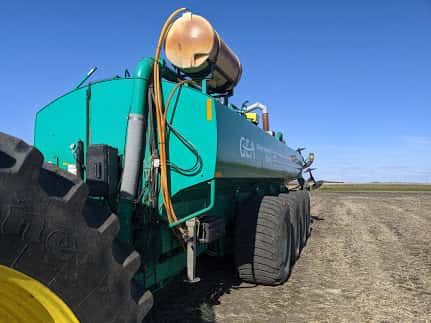
Courtesy of the University of Minnesota Extension, Minnesota Crop News.
By: Extension manure specialist Melissa Wilson and UMN soil scientist Jeff Vetsch
A nitrification inhibitor injection tank mounted on a manure applicator (Image credit: Melissa Wilson/University of Minnesota Extension)
Every fall we get questions about whether nitrification inhibitors work for fall manure applications. Do they keep nitrogen (N) from being lost? Do they help improve yields? To get right to the point, yes, sometimes, but not always.
Nitrification inhibitors prevent bacteria in the soil from converting the ammonium portion of N from the manure into nitrate. This reduces the risk of the nitrate leaching and denitrification, both of which remove N from the crop root zone. However, similar to how a pesticide wears off over time, nitrification inhibitors only last so long in the soil. This means that application timing is important.
Research in Minnesota
Two studies have been conducted in southern Minnesota using nitrapyrin, a nitrification inhibitor, for manure applications. The first study was conducted across seven sites over three years (1993-1995), while the second study was conducted at four sites over four years (2011-2014).
What was done?
In the ‘90s study, either liquid dairy or swine manure was applied in mid-September, mid-October, and mid-April the following year, and nitrapyrin was added to half of the plots. All manure was sweep-injected to about 4 to 5 inches deep. In May, corn was planted. The data collected included soil samples when the corn was at V4 (the 4th leaf collar on the corn had emerged) and corn yields. Soil samples were collected to 12 inches of soil depth and were only analyzed for nitrate.
In the more recent study from 2011-2014, liquid swine manure was applied mid-October or mid-November with or without nitrapyrin. All manure was sweep-injected and corn was planted the following May. The data collected included soil samples at corn planting and when the corn was at V4, as well as corn yields. Soil samples were collected to 12 inches of soil depth and were analyzed for both nitrate and ammonium.
What was found?
In the 90’s study, nitrapyrin increased soil nitrate concentrations in five out of seven sites when the corn was at the V4 growth stage. However, it only increased corn grain yields in two out of seven sites. One site in particular had a very wet spring (8.5 inches of rain fell over five weeks in May-June) and nitrapyrin increased yields when manure was applied in October, but not when it was applied in April or September. Overall, corn yields were highest when manure was applied in April, regardless of whether a nitrification inhibitor was used.
In the more recent study from 2011-2014, nitrapyrin significantly increased the amount of inorganic N in the ammonium form at corn planting, although this trend had disappeared by the V4 corn growth stage. Corn grain yields were improved with nitrapyrin in three of four years when manure was applied in October, but only two of four years when manure was applied in November. On average, corn yields for manure with nitrapyrin applied in October were the same as yields when manure was applied with or without nitrapyrin in November.
To summarize, nitrapyrin does help conserve soil nitrogen from fall-applied manure. It can help improve yields when manure is fall-applied in October, but may not be useful when manure is applied in September or November. In September, it is likely that nitrification inhibitors do not last long enough for the soil temperatures to drop. In November, soil temperatures in Minnesota are typically low (below 50°F) and nitrification is greatly slowed down naturally, so the inhibitors are not as effective.
What’s next?
Many questions remain. Do nitrification inhibitors only work with injected manure? Can the manure be broadcast and incorporated? Are there other nitrification inhibitors that would work with manure, like dicyandiamide (DCD)? Hopefully these questions will be answered in future studies.
